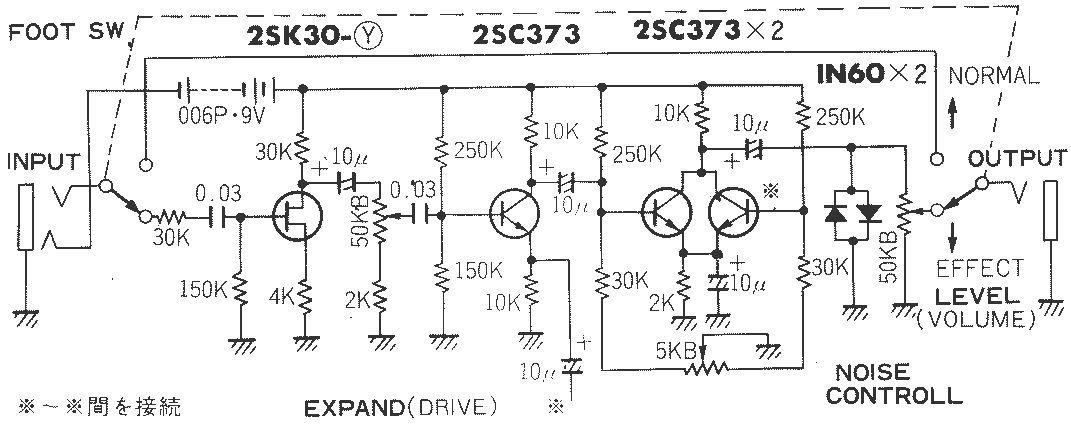Fuzzonaut
Well-known member
I grabbed these 2 PCBs just because they seemed interesting.
First up is something based on a schematic found in the Experimentalists Annonymous DIY Archives, labelled as "old school fuzz", this one:

Now, if anybody can tell me, what the "Noise Controll" (5kB) actually does, that would be welcome. And why would Nils change it to 50KB?
Well, anyway, it is a cool fuzz on guitar, does a great Garage/Surf/Trash sound. On bass, it's nice'n'nasty but a bit thin though, for my taste at least.
Japanese B movie film poster for graphics. I love those robots.


And then, there's this weird monstrosity: Honey Special Fuzz, apparently from 1968 ...
No idea what they were on while designing this, I mean you have 13 transistors, 2 transformers and a shitload of other components in there and all you get as far as potentiometers go, is a volume control at the very end of all that circuitery! Otherwise everything is fixed!

But what is it? - Well, actually, it's 2 things:
- a fuzz circuit, à la Superfuzz and
- an autowah (?)
The toggle switch let's you choose the routing, so to speak:
- up = left foot switch kicks in both: fuzz into wah (right footswitch does nothing)
- down = left footswich kicks in fuzz only, right footswitch activates wah only, while taking the fuzz out
At least, I think that's what's happening ...
The fuzz is pretty beefy and cool, the wah is kinda wonky, but then, I have zero experience with wah circuits, so what do I know?
I tried a lot of transistors in the wah section to get a presumably nice wooshy movement. I also fiddled with the transistors of the output section to get more volume because it got just a bit over unity when dimed. But that didn't really help, so I just added a LPB-1 (on vero, with 220N caps and 12k instead of 10K) after it and now it roars!
Another Japanese B movie poster for graphics. Robots carrying women ... a classic!

First up is something based on a schematic found in the Experimentalists Annonymous DIY Archives, labelled as "old school fuzz", this one:

Now, if anybody can tell me, what the "Noise Controll" (5kB) actually does, that would be welcome. And why would Nils change it to 50KB?
Well, anyway, it is a cool fuzz on guitar, does a great Garage/Surf/Trash sound. On bass, it's nice'n'nasty but a bit thin though, for my taste at least.
Japanese B movie film poster for graphics. I love those robots.


And then, there's this weird monstrosity: Honey Special Fuzz, apparently from 1968 ...
No idea what they were on while designing this, I mean you have 13 transistors, 2 transformers and a shitload of other components in there and all you get as far as potentiometers go, is a volume control at the very end of all that circuitery! Otherwise everything is fixed!

But what is it? - Well, actually, it's 2 things:
- a fuzz circuit, à la Superfuzz and
- an autowah (?)
The toggle switch let's you choose the routing, so to speak:
- up = left foot switch kicks in both: fuzz into wah (right footswitch does nothing)
- down = left footswich kicks in fuzz only, right footswitch activates wah only, while taking the fuzz out
At least, I think that's what's happening ...
The fuzz is pretty beefy and cool, the wah is kinda wonky, but then, I have zero experience with wah circuits, so what do I know?
I tried a lot of transistors in the wah section to get a presumably nice wooshy movement. I also fiddled with the transistors of the output section to get more volume because it got just a bit over unity when dimed. But that didn't really help, so I just added a LPB-1 (on vero, with 220N caps and 12k instead of 10K) after it and now it roars!
Another Japanese B movie poster for graphics. Robots carrying women ... a classic!

